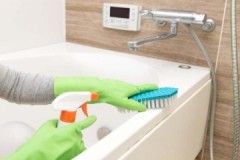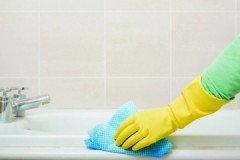Useful tips on how to remove odor from the bathroom drain
 Pleasant refreshing air is an indicator of a clean bathroom.
Pleasant refreshing air is an indicator of a clean bathroom.
However, in some cases, an irritating sewer odor may appear, which not only brings unpleasant sensations, but also carries a health hazard.
Therefore, when warning signs appear, it is imperative to find out and eliminate the cause of the problem, and in the future use preventive measures.
We will tell you about how to remove the smell from the sewer in the bathroom in the article.
Content
Why is ambergris from plums dangerous?
The composition of sewage water is rich in ammonia, hydrogen sulfide, methane and other substances that are formed during the decomposition of organic matter. Many of these compounds evaporate and enter the human respiratory tract with the air.
Most gases are poisonous and, with constant inhalation, cause serious health problems in residents:
 anxiety, nervousness;
anxiety, nervousness;- irritable behavior;
- sleep disturbance;
- rhinitis;
- bronchitis;
- nausea, vomiting;
- migraine;
- dizziness;
- violation of pressure;
- deterioration of vision.
Prolonged exposure to persistent sewer fumes can lead to general intoxication and diseases requiring medical attention.
Reasons for the appearance of an unpleasant odor
There are several main reasons for toxic fumes to leak. from the sewer. In each specific case, you should check all possible weak points and find the "root of evil" by exclusion.
Incorrect plumbing installation
Bathtub, sink, toilet bowl are installed and function in such a way that all drains enter the general drainage system. Each plumbing fixture, regardless of its purpose, is equipped with a siphon, which, when filled with water, forms a water seal.
When buying plumbing fixtures, it is recommended to choose specimens with a deep siphon and a large volume (at least 300 ml).
Drainage system design errors
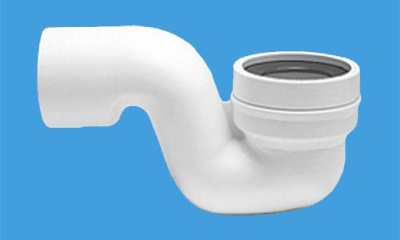 Competent installation of pipes and plumbing requires a fan pipe, through which the sewer riser is connected to the ventilation passage. The latter is displayed on the roof of the building.
Competent installation of pipes and plumbing requires a fan pipe, through which the sewer riser is connected to the ventilation passage. The latter is displayed on the roof of the building.
The consequence of improper installation or clogging of the drain pipe is the entry of air bubbles into the drainage riser through a siphon or pipe joints. As a result, the water seal "goes" into the sewer riser, and the gas barrier disappears.
Other reasons associated with the design and installation of a drainage system are:
- Failure to comply with the slope of the sewer pipe.
- Inaccurately selected pipe diameter.
- The beginning of the assembly of the structure is not from the bottom position.
Blockages
They are among the most common causes of foul-smelling odors. Small debris, wool, hair regularly enter the drain. Accumulating in the channel, they impede the flow of fluid.
Soon, the formed organic cork begins to decompose and create an unpleasant odor.
The situation is aggravated if a large object falls into the pipe... It creates a blockage in the flow path and collects all small debris.
Stagnation of sewage in the pipeline can lead to icing in the cold season.
Leaks
Much depends on the degree of adhesion of the pipe joints. If depressurization occurs and gaps appear at the joints, then the appearance of liquid waste in the bathroom is ensured. They help maintain odor and dirt.
Old metal pipes lead to the same problem.... Rust eats away at the metal, causing a gap or perforation. Liquid begins to seep through these holes.
Deterioration of ventilation
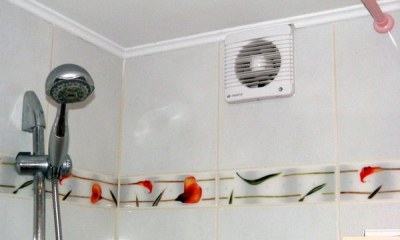 There must be a ventilation outlet in the plumbing room. If it is absent or clogged, odors and water vapor accumulate in the bathroom.
There must be a ventilation outlet in the plumbing room. If it is absent or clogged, odors and water vapor accumulate in the bathroom.
This contributes not only to the accumulation of gases in a confined space, but also to the development of pathogenic fungi.
Air stagnation in a small room can lead to:
- Clogged ventilation shaft in the house.
- Forced air flow from neighboring apartments.
How do I find the source of the problem?
To calculate the cause, it is necessary to sequentially check all possible points of the malfunction. These include:
- Checking the ventilation system. A piece of paper or a lighted match is applied to the grill of the hood. The deflection of the paper and the flame towards the shaft indicates a good outflow of air.
- Search for leaks. A clean napkin is carried through the sewer pipes. Particular attention is paid to the joints. Wet dirt is found to indicate cracks or gaps.
- Determination of the position of the sewer pipe. For this, use the building level. It will show if there is a necessary bias.
- Checking the drain. Testing is carried out with the water taps open as far as possible. Stagnation or slow flow of water from a sink or bathtub indicates a blockage.
How to fix it?
The solution to the issue depends on what caused the smell. Each specific case requires the use of your own skills, special tools or a call to the master.
Improved traction
You can improve ventilation in the bathroom in different ways, for this:
 a fan is installed on the hood, selecting it according to the volume of the bathroom;
a fan is installed on the hood, selecting it according to the volume of the bathroom;- an axial or duct model fan with a check valve is mounted on the ceiling;
- open the bathroom door at night to remove the airlock in the ventilation duct;
- make holes in the door leaf for more efficient air circulation around the room;
- with the help of a hook and a flashlight, dropped objects or debris are removed from the mine.
When the natural circulation of air in the bathroom is disturbed, it is necessary to install forced ventilation.
Pipe cleaning
If the odor is due to a blockage in pipes or a siphon, use a suitable cleaning method. There are three main methods.
- Chemical. The range of household chemicals offers powder, gel, granular products. The most popular are Mole, Mister Muscle, Bagi Pothan, HAAH, Chirton, PROSEPT and others.
- People's. To dissolve small plugs, use available tools (soda, vinegar, citric acid). The strong solution is poured into the drain hole and kept for 20 minutes. Then rinsed with tap water.
- Mechanical. It is possible to clear the clogged pipe bend under the sink using a plunger or manually by unscrewing the siphon. The blockage located far away is removed using a cable. It is lowered into the drain hole and pushed through the pipe with rotational movements.
Elimination of leaks
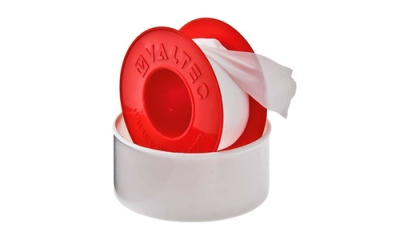 The detected cracks in the pipes are sealed with fum tape or special sealant. The latter method is considered more reliable.
The detected cracks in the pipes are sealed with fum tape or special sealant. The latter method is considered more reliable.
Different sealing materials are used to repair plumbing:
- silicone;
- acrylic;
- silicone acrylic;
- polyurethane.
Before applying the sealant to the pipe, its surface is cleaned, degreased and dried. Spread the mastic with a spatula making a continuous circular line. You can use the plumbing after the product has completely dried.
Correction of installation errors
This work is the most difficult, it is not always possible to carry it out on your own.... If the problem is caused by the lack of slope of the sewer pipe, then sometimes it is possible to put a small block or brick under the near end of the pipeline. The required slope is created, and the drains naturally go into the sewer.
When do you need to call a specialist?
Special situations require the intervention of a master. A professional with experience and a special tool will be able to fix the problem at a professional level.
It is necessary to contact specialists if:
- you cannot clean the ventilation shaft yourself;
- it is difficult to change an old unusable sewer pipe;
- you need to correct the incorrect installation of the plumbing fixture;
- mount forced ventilation in the bathroom;
- remove hard-to-reach blockage at the distal end of the pipe.
Preventive measures
Even if the bathroom's sewer system is not a concern, it is important to remember and apply preventive measures. They will provide fresh air in the room and protect the owner from unforeseen expenses.
Experts recommend:
 Install small nets on the drain of the sink and bathtub, which will retain debris and dirt.
Install small nets on the drain of the sink and bathtub, which will retain debris and dirt.- When changing plumbing fixtures, change old pipes in parallel.
- Periodically rinse the drain coming from the sink and bathtub with boiling water.
- After 1-2 months, flush the pipes with special chemistry or homemade composition.
- Check the condition of ventilation and sewerage every six months.
Additional Tips
To protect yourself from the problem of unpleasant odor in the bathroom, it is worth listening to the following recommendations:
- Entrust the development of the project and installation of the home drainage system to experienced professionals.
- When choosing a sealant for sealing cracks, it is advisable to give preference to formulations that contain antibacterial and fungicidal additives.
- In summer, without using the siphon, it dries up quickly; to restore the hygienic state of the bathroom, it is enough to pour water into it.
All the most important and useful information about bathroom cleaning is collected in this section of the site.
Related videos
The reasons for the smell from the sewer and how to eliminate them are in the video:
Conclusion
An unpleasant smell of sewage in a plumbing room is a common problem. Its reasons can be associated with both the drainage system itself and the operation of ventilation.
You can fix the problem yourself, using cleaning, sealing pipes, improving ventilation, correcting the structural elements of the system. In difficult situations, it is recommended to contact a specialist.

